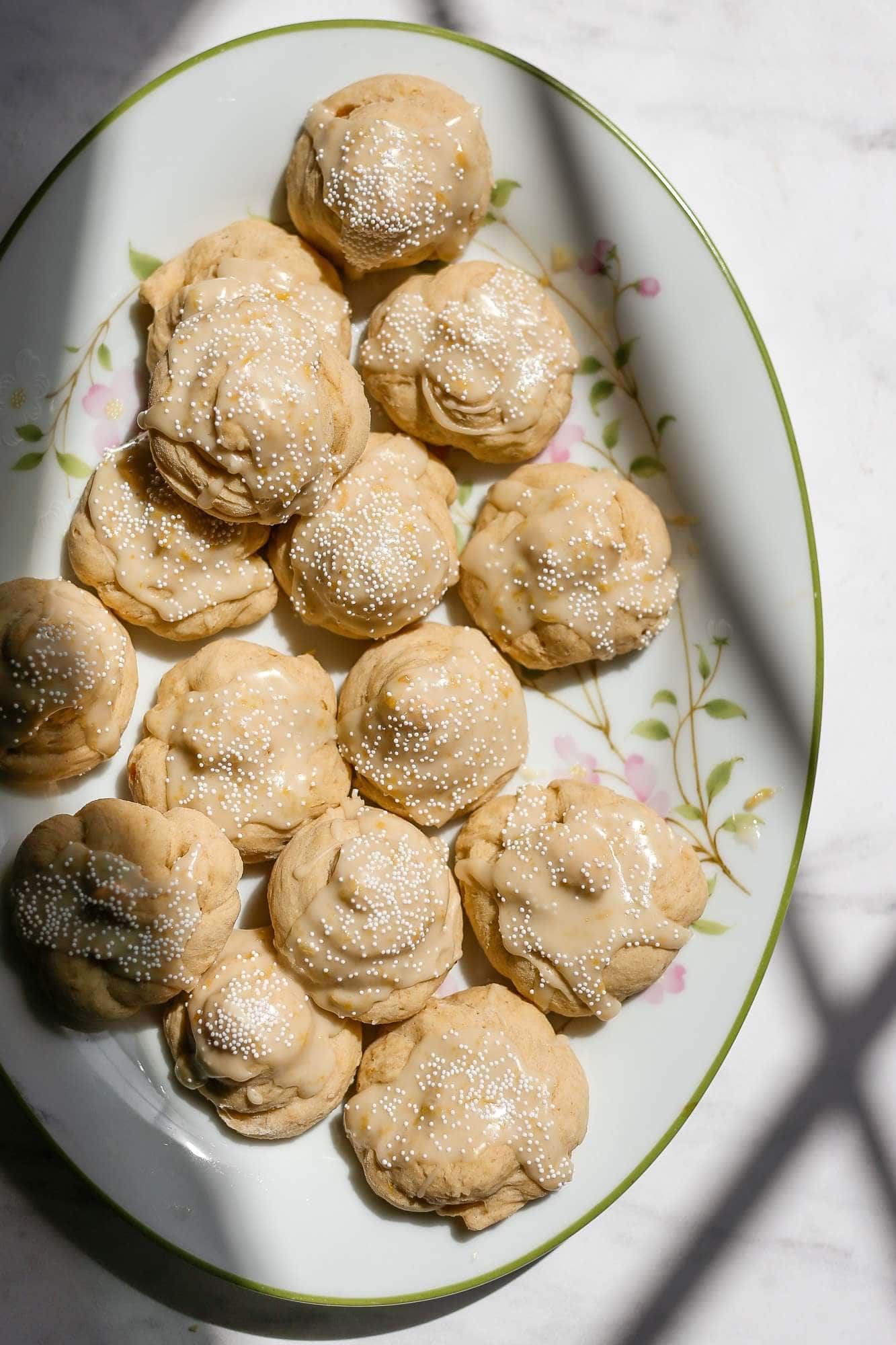Embrace the vibrant zest of spring with our Italian Easter Cookies, featuring fermented lemon in the dough and lemon-infused icing. This recipe, enriched with sourdough discard, promises a delightful tanginess and a tender crumb, making each bite a celebration of lemony bliss.
What is Uncinetti?
“Uncinetti” refers to a specific type of cookie often made to celebrate Easter in certain Italian regions. Like many traditional Italian Easter sweets, these cookies carry the heritage and customs of Italian baking.
While not as universally recognized as other Italian Easter treats, such as Colomba di Pasqua (Easter Dove Bread) or Pastiera Napoletana, Uncinetti cookies are part of the diverse and rich tapestry of Italian seasonal baking.
The name “Uncinetti” indicates the shape or decorative style of these cookies, suggesting something small, curved, or intricately designed, perhaps resembling the hook of a crochet needle (“uncinetto” in Italian).
Italian Easter cookies vary widely in ingredients and form. Still, many share features such as being slightly sweet, sometimes incorporating citrus flavors like lemon or orange, and often being decorated with a simple glaze or sprinkles.
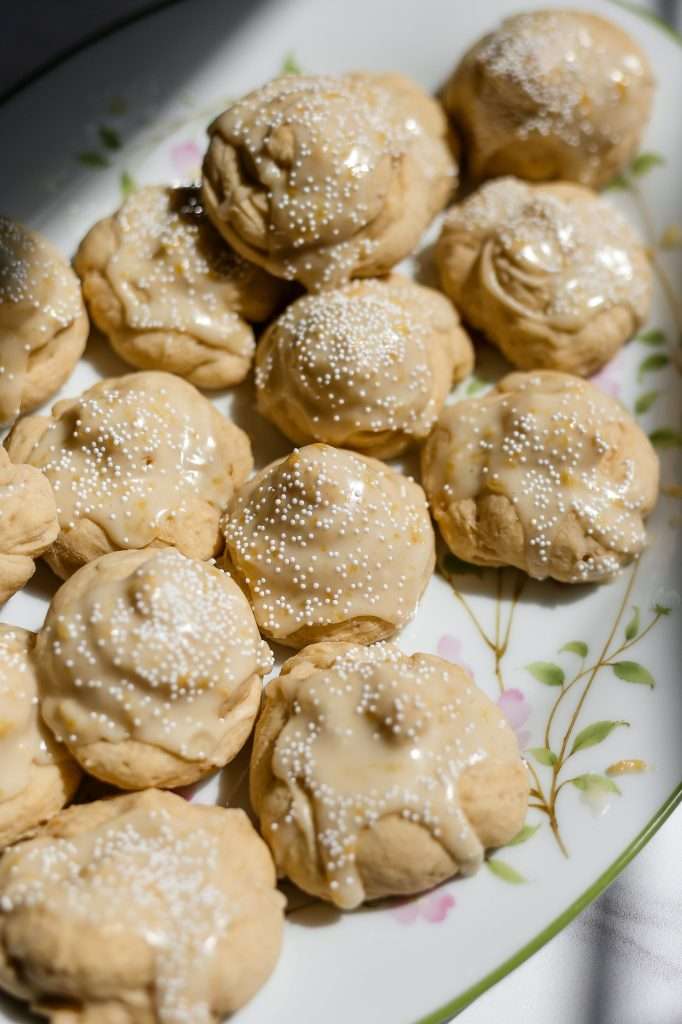
Lemon Italian Easter Cookies
Though specific recipes for Uncinetti cookies might vary, traditional Italian Easter cookies often include eggs, sugar, butter, and flour. Some bakers flavor the cookies with vanilla, almond extract, or citrus zest.
Traditionally, people shape the dough by hand and then bake until lightly golden. After cooling, they can be glazed with a simple mixture of powdered sugar and lemon juice or milk and adorned with sprinkles.
These Italian Easter cookies have a cake-like, almost bready texture. They’re rich with a light lemony flavor and perfect for spring.
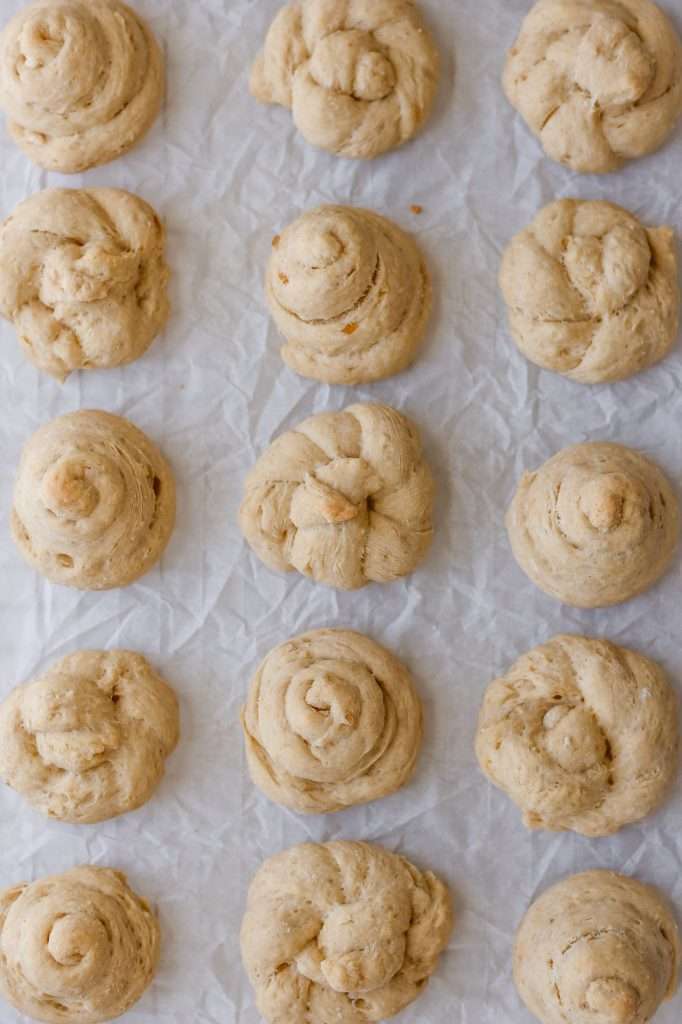
Italian Easter Cookies with Sourdough Discard
You can use discard straight from the fridge or an active bubbly starter in this recipe. We consider these “sourdough discard” cookies because you use sourdough starter in the recipe, but we don’t use it for rising, and it is not necessary for the baking process.
So, we technically “discard” the starter into the recipe. I use a stirred-down, active, bubbly sourdough starter in all of my sourdough cookie recipes. You can use flat sourdough discard from the fridge if you prefer.
You can absolutely long ferment this Italian Easter cookie dough so it is easier to digest. If digestibility is a concern for you, you’ll want to use an active bubbly sourdough starter.
Once you have mixed the cookie dough, ferment it in the fridge for 24 hours before shaping and baking.
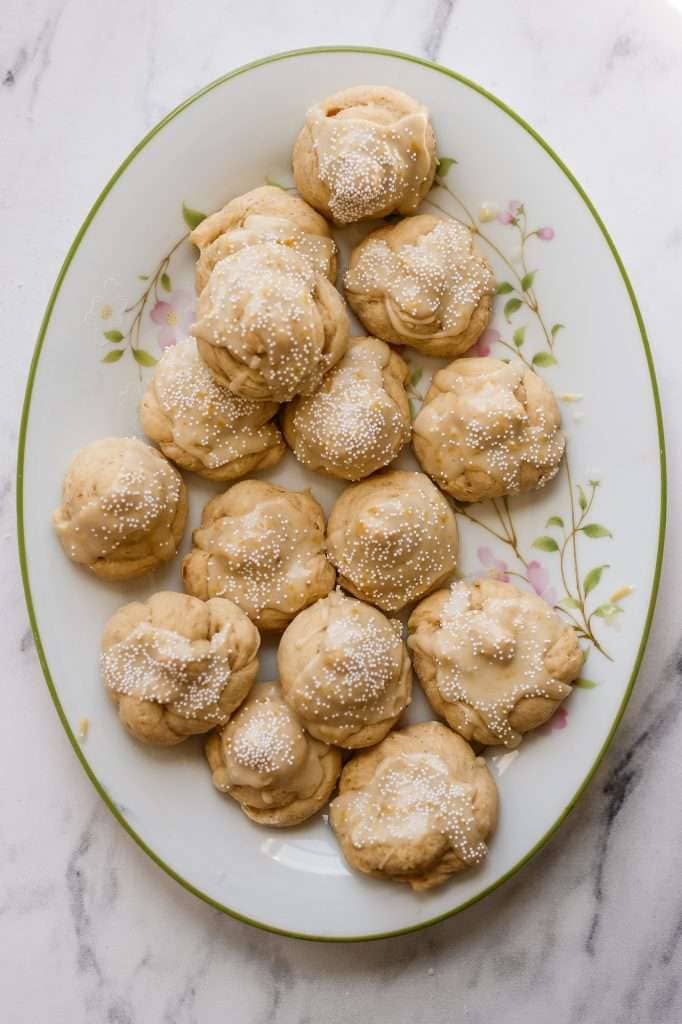
Easter Cookies Lemon Icing
To make the lemon icing glaze, add the sifted powdered sugar, lemon juice, zest, and milk to a small bowl and combine. Note that you can adjust the icing to your desired thickness by adding less or more milk. Start with a tiny bit of milk, and add a little more gradually until the icing is the thickness you prefer.
I like to add fresh lemon zest to the icing, but this makes the icing not last as long. For a longer-lasting icing, leave the lemon zest out.
Italian easter cookies usually have sprinkles on top. I chose an elegant and minimal look with classic white nonperil sprinkles.
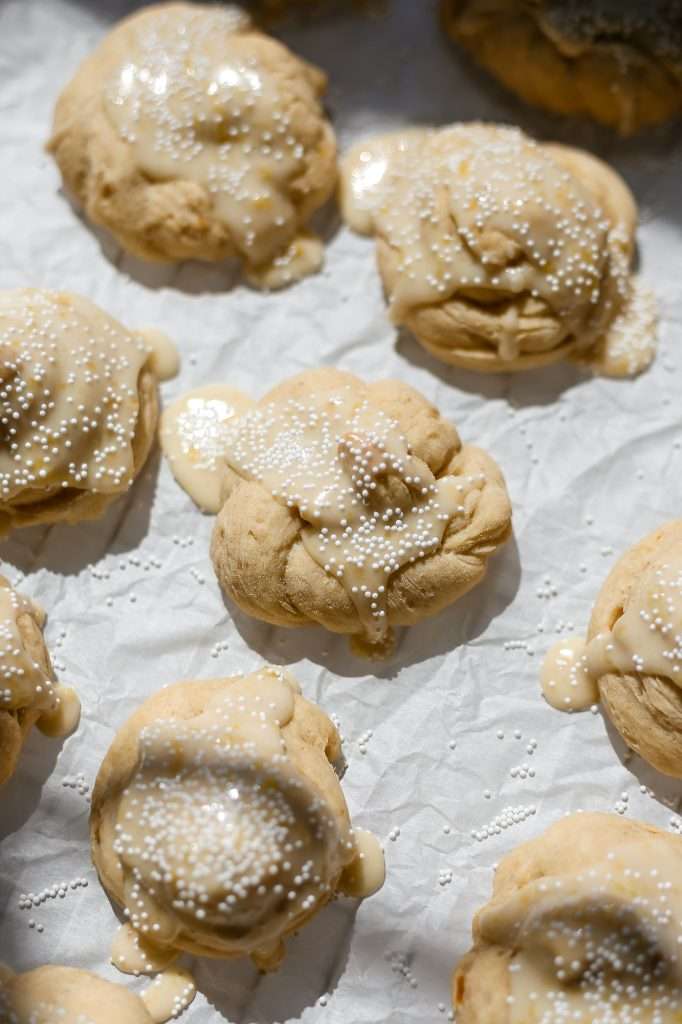
Shaping Italian Easter Cookies
To shape these cookies, divide the dough into 16 equal pieces. Then, roll each piece out into a long tube shape with your hands. You’ll want to do this on a well-floured surface. Once the dough is rolled out into long tube shapes, you can roll them up like a cinnamon roll shape or twist them.

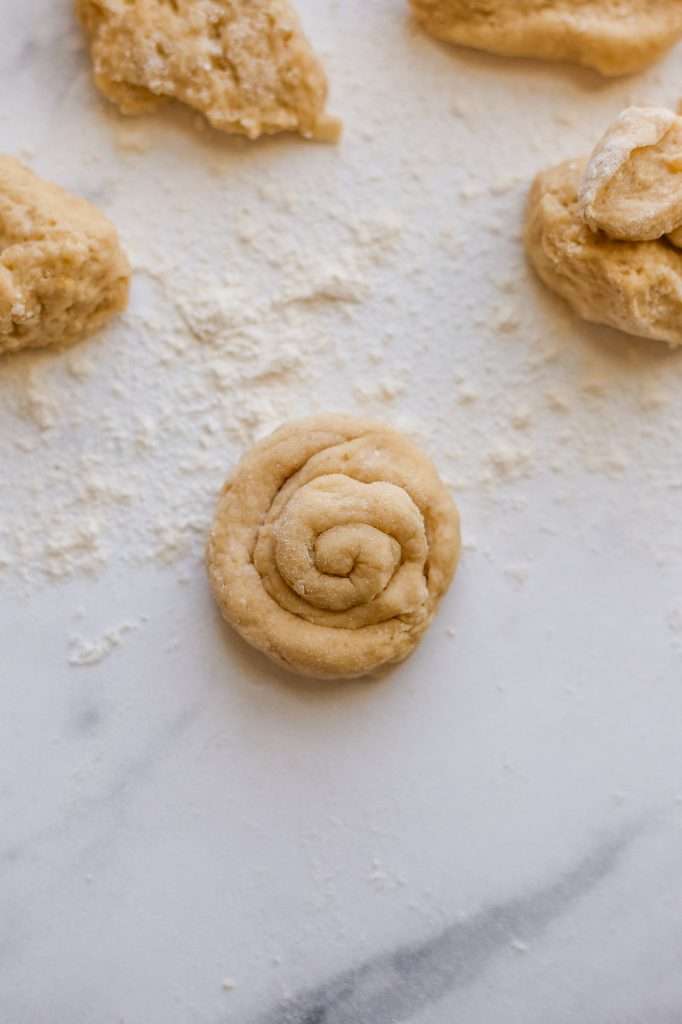
I stuck to two simple shapes, and I think they were perfect. For the twists, I rolled a longer, thinner tube. Then, I split it in half and twisted the two pieces into a circular shape.
Once you have all the dough shaped, they’re ready to bake. After baking, allow the cookies to cool completely before adding the icing.

How to Store These Easter Cookies
Here’s how to store these cookies properly:
Allow to Dry Completely
- Before storing, ensure the icing has dried completely. This can take anywhere from 8 to 24 hours, depending on the icing thickness and humidity levels. Cookies should be left in a single layer during this time to dry evenly and prevent smudging.
Choose the Right Container
- Once the icing is dry, transfer the cookies to an airtight container. Since the cookies are soft, a rigid container is preferable to prevent them from getting crushed.
Layering Cookies
- If you need to stack the cookies, place a piece of parchment paper, wax paper, or a reusable non-stick liner between each layer to prevent them from sticking together and to protect the icing designs.
Room Temperature Storage
- Store the container at room temperature in a cool, dry place. Avoid direct sunlight, as it can make the cookies humid or stale. Most cookies with icing will keep well for up to one week when stored this way.
Avoid Refrigeration
- Refrigeration can cause condensation on the cookies, softening the icing and making it runny. It’s best to avoid refrigerating.
Freezing
- Cookies with lemon icing can be frozen for longer storage. First, place the cookies in a single layer on a baking sheet to freeze them individually. Once frozen, transfer them to an airtight container, separating layers with parchment paper. To thaw, remove them from the container and let them come to room temperature on a wire rack to prevent condensation from softening the icing.
Tips for Best Results
- Check the cookies after a day or two to ensure no moisture has gotten into the container. If you notice any condensation, remove the lid for a few hours to let the moisture evaporate.
By following these storage tips, your decorated cookies should maintain their beauty and taste as good as the day they were made.
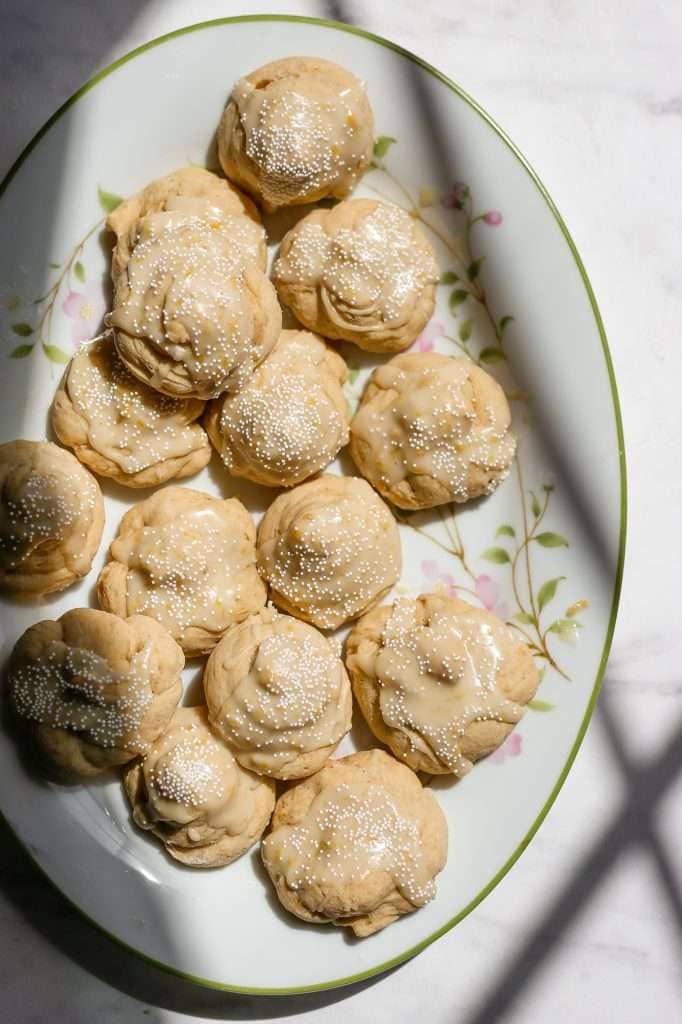
More Sourdough Cookie Recipes to Try
- Sourdough Lemon Blueberry Cookies (Blueberry Muffin Cookies)
- S’mores Cookies with Marshmallows and Brown Butter
- Sourdough Chocolate Strawberry Cheesecake Cookies

Sourdough Discard Italian Easter Cookies (Uncinetti)
Embrace the vibrant zest of spring with our Italian Easter Cookies, featuring fermented lemon in the dough and lemon-infused icing. This recipe, enriched with sourdough discard, promises a delightful tanginess and a tender crumb, making each bite a celebration of lemony bliss.
- Prep: 15 minutes
- Cook: 20 minutes
- Total Time: 35 minutes
Ingredients
cookie dough
- 200 grams all purpose flour
- 40 grams granulated sugar
- 1 teaspoon baking powder
- 1/4 tsp salt
- About 1 tablespoon fermented lemon peel, rinsed and minced (or zest of one lemon)*
- 1 large egg
- 50 grams unsalted butter (melted and cooled)
- 60 grams whole milk
- 60 grams sourdough starter (thick, not watery)
Lemon glaze
- 3/4 cups powdered / icing sugar
- 1 teaspoon lemon juice
- zest of 1 lemon*
- 2–3 teaspoon milk (approximately)
Instructions
- Preheat oven to 325°F. Line a large cookie sheet with parchment paper.
- Whisk together the flour, sugar, baking powder, salt, and fermented lemon peel (or lemon zest) in a large bowl. Make a well in the middle of the dry ingredients and add the egg, butter, starter, and milk. With a fork, combine until a mixture of rough dough forms.
- Move it to a floured surface and gently knead to form a smooth dough.
- Divide pieces of the dough to form 5-6 inches (13-16 cm) ropes. Make sure the ropes are quite thin, then form them into a knot, roll, or twist.
- Place on the prepared cookie sheet and bake for approximately 15-18 minutes or until lightly golden.
- To make the glaze, add the sifted powdered sugar, lemon juice, zest, and milk to a small bowl and combine to your desired thickness (less or more milk as needed).
- Let cool completely, then cover with lemon glaze and sprinkles.
Notes
- I like to add fresh lemon zest to the icing, but this makes the icing not last as long. For a longer-lasting icing, leave the lemon zest out.
- To use fermented lemon peel in the dough, remove the pulp from the peel, rinse the peel well under cool water, then mince.



